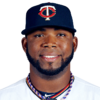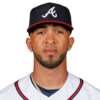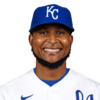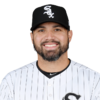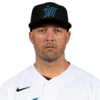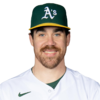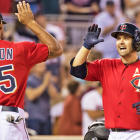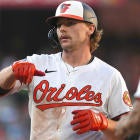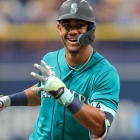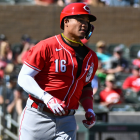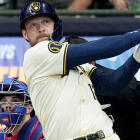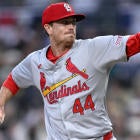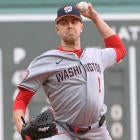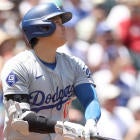It might be hard to tell, but the if you squint, you can start to make out the light at the end of the tunnel for the Twins.
Coming off the worst season in franchise history and five seasons of 90-plus losses out of six, that might be hard to believe, but the Twins have plenty of young talents with huge upside who could be ready to take a big step forward.
Of course, the Twins have a collection of especially volatile elite young players, headlined by Miguel Sano, Jose Berrios and Byron Buxton. There is no denying the talent these players have, but the results so far at the major-league level haven't quite matched the huge expectations each carried from their minor league days. We'll have more about Sano and Berrios later, but Buxton might embody the wide range of outcomes the Twins are facing better than anyone.
Buxton has had three stints in the majors, and the first two were pretty much disasters. The strikeouts wouldn't have been so bad, but Buxton wasn't even showing the ability to do anything even when he managed to make contact. That's what changed last September, as Buxton hit .287/.357/.653 with nine homers in 29 games; sure he struck out 38 times, but at least he made pitchers pay when he wasn't fooled.
Now that we've seen what Buxton can do, it's easy to buy into a big breakout season for him. If you believe September was more the real Buxton than his previous attempts in the majors, it's easy to be optimistic about a brighter future for the Twins. However, there were still enough red flags that we should have doubts.
The Twins could turn this thing around quickly. But, even this deep into the rebuild, it's no sure thing.
| 1 | 
Brian Dozier
2B
|
| 2 | |
| 3 |
Joe Mauer
1B
|
| 4 |
Miguel Sano
3B
|
| 5 |
Max Kepler
RF
|
| 6 | |
| 7 | |
| 8 |
Byron Buxton
CF
|
| 9 | |
| Bench | 
Byung Ho Park
1B
|
| Bench | |
| 1 |
Ervin Santana
RHP
|
| 2 |
Hector Santiago
LHP
|
| 3 |
Kyle Gibson
RHP
|
| 4 | 
Phil Hughes
RHP
|
| 5 |
Jose Berrios
RHP
|
| Alt SP | 
Tyler Duffey
RHP
|
| Closer |
Brandon Kintzler
RHP
|
| Setup | 
Glen Perkins
RHP
|
| Relief |
Ryan Pressly
RHP
|
| Relief |
Trevor May
RHP
|
| Relief |
Taylor Rogers
LHP
|
Can Brian Dozier sustain last year's power?
If Dozier had followed his established pattern, it would have been reasonable to expect him to break 30 homers for the first time in 2016. He had increased his output by five in each of the previous two seasons, without showing much sign of having some kind of huge ceiling. Incremental improvements are still improvements even if they are hard to get excited about.
However, a 50 percent increase? Now that gets the blood flowing. Dozier obliterated his career-high in home runs in 2016, clubbing 42, which brought a career-best mark in RBI along with it. In nearly every regard, Dozier had a career-best season in 2016, so the question moving forward is whether you can append "so far" to that previous statement, or if he truly peaked last season.
The good news is that Dozier did make some concrete improvements to his game, posting the highest hard-hit rate and fly-ball rate of his career. If you want to take a big step forward in power, that's the straightest line to get to that outcome. Dozier seemed to tailor his swing to generate more loft, and his dead-pull tendencies only helped. Dozier also increased his average home run distance by more than 10 feet, per HitTrackerOnline.com.
Dozier may never have a season as good as 2016 again, but that doesn't mean you should expect him to regress all the way to his prior levels. He made real changes, while also benefiting from natural improvements in his swing. He is still a strong candidate for a trade, but that would likely only help things along, as Dozier would likely be moving to a better lineup. The arrow is definitely pointing up here.
Does Sano have a breakout in him?
If everything breaks right, the Twins could be just the fourth team since 2006 to have two 40-homer players. Dozier has already done it, obviously, but Sano still has some improvement needed to reach that level. There's no question he has the raw power to hit 40 homers, but strikeouts have limited his effectiveness so far. Can he fix that flaw in his game?
Sano's got plenty of swing and miss, but not so much that it should be this big of an issue. Among 232 hitters who had at least 350 plate appearances last season, he ranked 28th in swinging strike rate, despite leading that group in strikeout rate. The problem is, Sano is just a bit too selective. He has the same swinging strike rate as J.D. Martinez, for instance, but swings at just 62.9 percent of pitches in the zone and 41.0 percent overall; Martinez swings at 77.1 percent of in-zone pitches and 52.5 percent overall, and sports a 24.8 percent K-rate as a result.
Being patient isn't an inherently bad thing, just like being aggressive isn't a panacea. Still, when someone swings as big a bat as Sano, you want to see them use it more. It's not like he is sporting a Joey Votto-esque walk rate, so Sano could probably stand to benefit from a more aggressive style at the plate. If he can get his strikeout rate to the 25-28 percent range, he could have a (healthy) Giancarlo Stanton-like impact. The potential is high.
Can Jose Berrios be an ace?
The knock on Berrios wasn't supposed to be readiness or control. Heading into the 2016 season, he was considered a fairly polished minor-league product, after posting a 3.03 ERA in 166 1/3 innings in 2015. He held true to that at Triple-A in 2016, with a 2.51 mark in 17 starts, but his time in the majors can be charitably described as a disaster.
Berrios didn't strike many batters out, couldn't keep the ball in the yard, and couldn't throw strikes, which is a pretty good combination if you want an 8.02 ERA. It was a disappointing showing for a prospect whose greatest asset was supposed to be his polish; he might not have SP1 upside, but Berrios should have been able to hold his own with three plus pitches and strong control.
That he flopped that hard makes it tough to get too excited about him, but that might not be bad news. Berrios can fly under the radar this draft season, allowing you to snag him at a steeply discounted price. He still has the upside and skill set everyone saw last year, and as a late-round flier, he should be a nice pickup.






